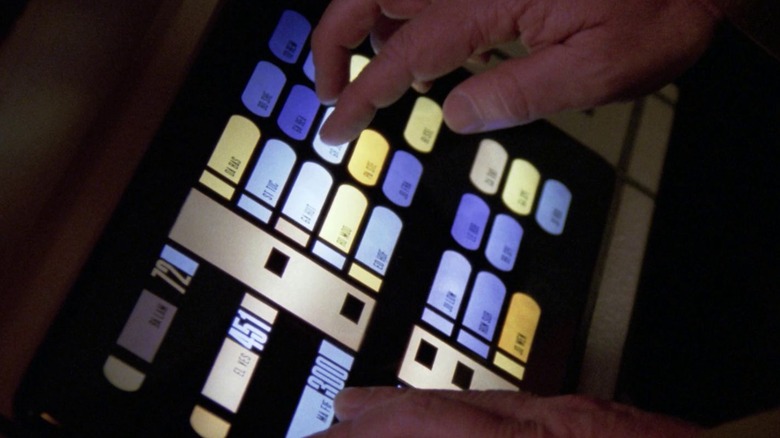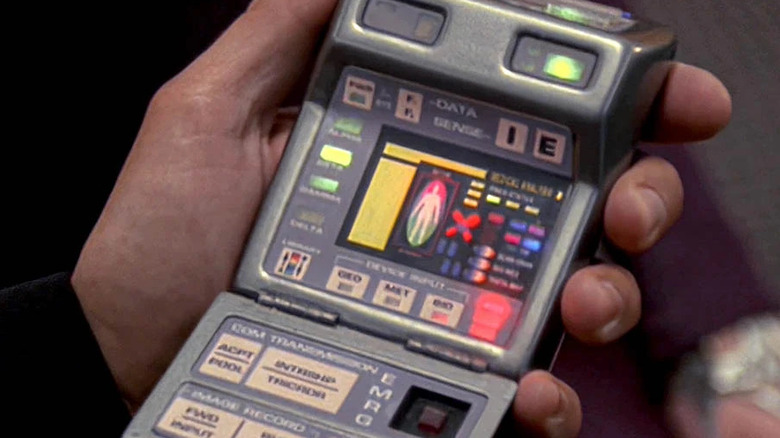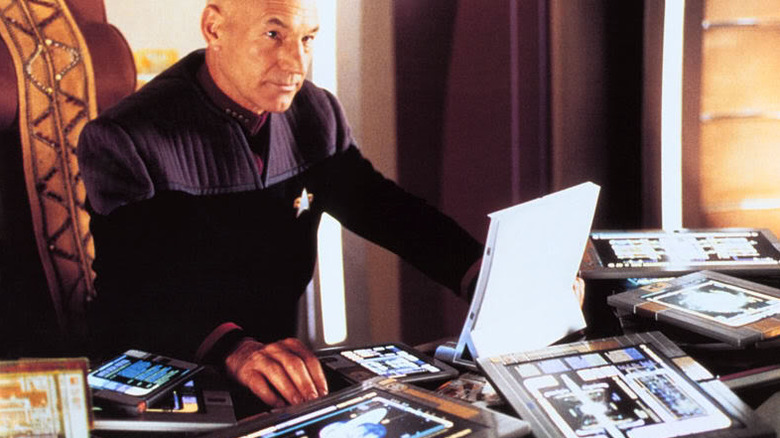We might obtain a fee on purchases constituted of hyperlinks.
On the unique “Star Trek,” the computers on the U.S.S. Enterprise had been operated by a sequence of switches, dials, knobs, and buttons, lots of them unlabeled. For probably the most half, the switches’ capabilities remained obscure to viewers. It appeared {that a} expert Starfleet officer, whereas sitting on the bridge, would merely should know which switches activated what system simply to carry out even probably the most fundamental duties on board a starship. Maybe attentive Trekkies might have been capable of look intently on the “Star Trek” actors and discern what buttons they had been pushing when Captain Kirk (William Shatner) gave an order to go to warp, however mentioned actors might admit that they roughly pushed buttons at random.
On “Star Trek: The Subsequent Era,” the pc panels grew to become far sleeker and extra refined. The knobs and dials had been changed by flat, glowing contact panels, every of them emblazoned by sq. “home windows,” weirdly numbered subroutines, and dozens of oval-shaped buttons. Officers on board the Enterprise-D regarded like typists, always inputting data into their private contact panels.
Though by no means talked about by title on “Subsequent Era,” the pc graphical interface was referred to as LCARS. This time period is taken from many, many extant expanded universe texts, most notably Rick Sternbach and Michael Okuda’s 1991 sourcebook “Star Trek: The Next Generation Technical Manual,” a must-own for deep-cut Trekkies. In response to that e-book, LCARS stands for “Library Pc Entry/Retrieval System.”
LCARS wasn’t an obscure element. It was the fundamental design of all starships on “Star Trek” from 1987 via 2001 earlier than later being introduced again for among the newer “Star Trek” reveals within the ’20s.
LCARS, Okudagrams, and different enjoyable nerdy particulars about Star Trek computer systems
There have been a couple of notable close-ups of the LCARS tools all through the “Star Trek” franchise, and one can see that an excessive amount of consideration went into its design. LCARS was invented and designed by Michael Okuda, who adopted a mandate from “Star Trek” creator Gene Roddenberry. The computer systems on “Subsequent Era” needed to look extra superior than those on the unique sequence, so Okuda (who’s been involved with multiple “Star Trek” projects, including “Star Trek VI: The Undiscovered Country”) invented the screen-based contact panels in response. The concept was to have much more visible exercise on the Enterprise’s laptop screens, implying that hundreds of thousands of actions wanted to be taken every day simply to maintain the ship going.
Okuda’s designs prolonged to tricorders as nicely, and some close-ups of the hand-held, flip-open scanners revealed that they, too, are difficult items of equipment and wish lots of adjustment to function correctly. One may additionally see the LCARS designs on a PADD (Private Entry Show System), which is the “Star Trek” equal of a modern-day pill. In 1987, a PADD was high-tech; in 2025, it is in everybody’s front room. Okuda’s designs additionally made the computer systems on “Star Trek” look troublesome and byzantine which, oddly, made them extra sensible. It was good to assume that the computer systems on “Star Trek” had been so unbearably refined that one would require particular coaching to function them.
An excellent nearer take a look at the LCARS panel may reveal that many of the buttons are marked with obscure five-letter codes, often introduced in a two-letter-space-three-letter configuration. Trekkies will have the ability to inform you that these five-letter codes are colloquially known as Okudagrams, whereas the letters are the initials of individuals on the “Star Trek” manufacturing workforce.
The continued used of LCARS all through Star Trek
Paramount, in fact, owns the rights to the LCARS design and has needed to take authorized motion in opposition to people who design telephone apps that’ve used an LCARS format and coloration scheme. Some modern-day laptop corporations, nonetheless, have licensed the LCARS design, and Trekkies can now use PADDs just about in actual life.
There have additionally been a couple of cases all through the “Star Trek” franchise the place it has been implied that sure LCARS programs are operated on PADDs that produce tactile, “raised-button” programs, permitting them to be operated by visually impaired officers.
LCARS was in use with just about the identical design all through Nineteen Nineties “Star Trek” reveals and was redesigned somewhat bit for latter-day “Star Trek” motion pictures. The hotter lavenders, golds, and beiges gave technique to steelier blues and whites. The traditional system was introduced again for “Star Trek: Decrease Decks” in 2020 (“Decrease Decks” is ready just a few years after the tip of “Subsequent Era”). In the timeline of “Star Trek: Picard,” a sequence set a number of many years after “Subsequent Era,” LCARS had partially moved from PADDs and panels to hovering, translucent holographic shows. These sorts of shows, nonetheless, had been often solely seen in convention rooms or in individuals’s properties. For probably the most half, touchscreen LCARS panels remained in place as the usual on starship workstations.
Within the early days of “Subsequent Era,” the LCARS shows had been lit by rotating lighting fixtures and did not have lots of notable graphics, which might have been troublesome to attain in 1987. It wasn’t till a lot later that manufacturing workers would set up the “Star Trek” units with precise TV screens.
We might obtain a fee on purchases constituted of hyperlinks.
On the unique “Star Trek,” the computers on the U.S.S. Enterprise had been operated by a sequence of switches, dials, knobs, and buttons, lots of them unlabeled. For probably the most half, the switches’ capabilities remained obscure to viewers. It appeared {that a} expert Starfleet officer, whereas sitting on the bridge, would merely should know which switches activated what system simply to carry out even probably the most fundamental duties on board a starship. Maybe attentive Trekkies might have been capable of look intently on the “Star Trek” actors and discern what buttons they had been pushing when Captain Kirk (William Shatner) gave an order to go to warp, however mentioned actors might admit that they roughly pushed buttons at random.
On “Star Trek: The Subsequent Era,” the pc panels grew to become far sleeker and extra refined. The knobs and dials had been changed by flat, glowing contact panels, every of them emblazoned by sq. “home windows,” weirdly numbered subroutines, and dozens of oval-shaped buttons. Officers on board the Enterprise-D regarded like typists, always inputting data into their private contact panels.
Though by no means talked about by title on “Subsequent Era,” the pc graphical interface was referred to as LCARS. This time period is taken from many, many extant expanded universe texts, most notably Rick Sternbach and Michael Okuda’s 1991 sourcebook “Star Trek: The Next Generation Technical Manual,” a must-own for deep-cut Trekkies. In response to that e-book, LCARS stands for “Library Pc Entry/Retrieval System.”
LCARS wasn’t an obscure element. It was the fundamental design of all starships on “Star Trek” from 1987 via 2001 earlier than later being introduced again for among the newer “Star Trek” reveals within the ’20s.
LCARS, Okudagrams, and different enjoyable nerdy particulars about Star Trek computer systems
There have been a couple of notable close-ups of the LCARS tools all through the “Star Trek” franchise, and one can see that an excessive amount of consideration went into its design. LCARS was invented and designed by Michael Okuda, who adopted a mandate from “Star Trek” creator Gene Roddenberry. The computer systems on “Subsequent Era” needed to look extra superior than those on the unique sequence, so Okuda (who’s been involved with multiple “Star Trek” projects, including “Star Trek VI: The Undiscovered Country”) invented the screen-based contact panels in response. The concept was to have much more visible exercise on the Enterprise’s laptop screens, implying that hundreds of thousands of actions wanted to be taken every day simply to maintain the ship going.
Okuda’s designs prolonged to tricorders as nicely, and some close-ups of the hand-held, flip-open scanners revealed that they, too, are difficult items of equipment and wish lots of adjustment to function correctly. One may additionally see the LCARS designs on a PADD (Private Entry Show System), which is the “Star Trek” equal of a modern-day pill. In 1987, a PADD was high-tech; in 2025, it is in everybody’s front room. Okuda’s designs additionally made the computer systems on “Star Trek” look troublesome and byzantine which, oddly, made them extra sensible. It was good to assume that the computer systems on “Star Trek” had been so unbearably refined that one would require particular coaching to function them.
An excellent nearer take a look at the LCARS panel may reveal that many of the buttons are marked with obscure five-letter codes, often introduced in a two-letter-space-three-letter configuration. Trekkies will have the ability to inform you that these five-letter codes are colloquially known as Okudagrams, whereas the letters are the initials of individuals on the “Star Trek” manufacturing workforce.
The continued used of LCARS all through Star Trek
Paramount, in fact, owns the rights to the LCARS design and has needed to take authorized motion in opposition to people who design telephone apps that’ve used an LCARS format and coloration scheme. Some modern-day laptop corporations, nonetheless, have licensed the LCARS design, and Trekkies can now use PADDs just about in actual life.
There have additionally been a couple of cases all through the “Star Trek” franchise the place it has been implied that sure LCARS programs are operated on PADDs that produce tactile, “raised-button” programs, permitting them to be operated by visually impaired officers.
LCARS was in use with just about the identical design all through Nineteen Nineties “Star Trek” reveals and was redesigned somewhat bit for latter-day “Star Trek” motion pictures. The hotter lavenders, golds, and beiges gave technique to steelier blues and whites. The traditional system was introduced again for “Star Trek: Decrease Decks” in 2020 (“Decrease Decks” is ready just a few years after the tip of “Subsequent Era”). In the timeline of “Star Trek: Picard,” a sequence set a number of many years after “Subsequent Era,” LCARS had partially moved from PADDs and panels to hovering, translucent holographic shows. These sorts of shows, nonetheless, had been often solely seen in convention rooms or in individuals’s properties. For probably the most half, touchscreen LCARS panels remained in place as the usual on starship workstations.
Within the early days of “Subsequent Era,” the LCARS shows had been lit by rotating lighting fixtures and did not have lots of notable graphics, which might have been troublesome to attain in 1987. It wasn’t till a lot later that manufacturing workers would set up the “Star Trek” units with precise TV screens.





















